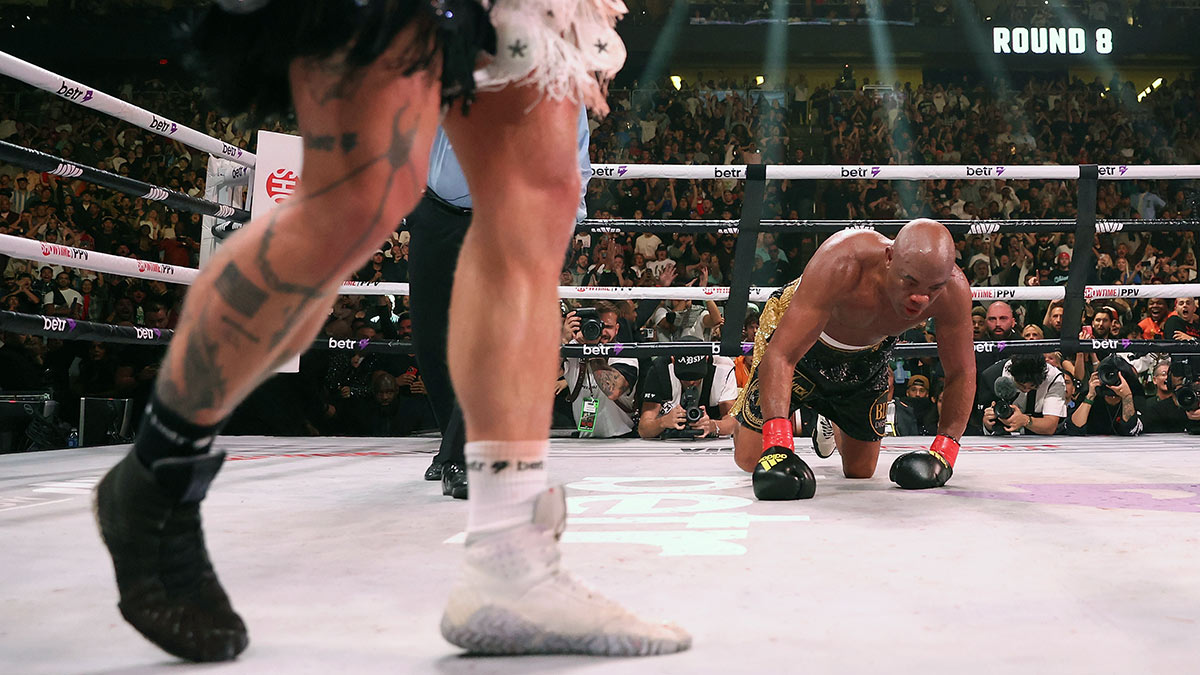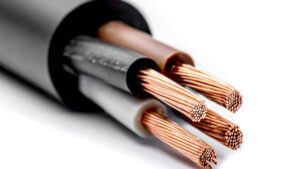Resources Top 5: Rare earths acquisitions, impending lithium results, and a battered HPA stock drags itself off the canvas

Anderson Silva of Brazil reacts after a knock-down from Jake Paul during their cruiserweight bout on October 29, 2022 in Glendale, Arizona. (Photo by Christian Petersen/Getty Images)
- Mt Monger Resources to buy Pomme hard rock rare earths project in Quebec, Canada
- High purity alumina stock FYI Resources has partially bounced back from yesterday’s precipitous +60% fall
- Results from maiden drilling at Firetail Resources’ Yalgoo lithium project due any day
Here are the biggest small cap resources winners in early trade, Thursday February 23.
MT MONGER RESOURCES (ASX:MTM)
MTM will buy the Pomme hard rock rare earths project in Quebec, Canada, from TSX listed explorer Geomega Resources for ~$1m in cash and shares.
The company says it has similar geology to Geomega’s advanced 266Mt Montviel carbonatite REE-Nb deposit, just 7km away.
Just two holes were punched into Pomme back in 2012, but they both returned thick mineralised intersections interspersed with high grade chunks, including a highlight 508.3m @ 0.43% TREO, 413ppm Nb2O5 and 1.48% P2O5, from 73.7m depth.
Fieldwork at Pomme, including diamond drilling, is expected to commence after spring thaw in May 2023.
“It is rare that a project with the outstanding early drill results and this type of significant geological potential can be secured at the pre-resource exploration stage,” MTM managing director Lachlan Reynolds says.
“Pomme is a known carbonatite intrusion and the limited diamond drilling completed more than a decade ago has confirmed the presence of extensive rare earth element and niobium mineralisation with globally significant intercept widths.
“The project has excellent geological potential for the discovery of a resource.”
The $5m capped minnow is up 25% in 2023. It had $1.9m in the bank at the end of December.
FYI RESOURCES (ASX:FYI)
Battered high purity alumina stock FYI has partially bounced back from yesterday’s precipitous +60% fall.
Th selloff began after US aluminium giant Alcoa pulled out of a deal to develop FYI’s advanced HPA project in Perth, WA.
The now scrapped agreement – which wasn’t popular with shareholders either — would’ve seen Alcoa acquire 65% of the project by spending $US243m on project development.
The project now reverts to FYI, who will develop an alternative plan and schedule for development with a “speed to market” approach.
“While this is not the outcome we envisaged, the HPA project has advanced considerably, benefitting from Alcoa’s rigour and US$5 million investment,” FYI managing director Roly Hill says.
“We will move ahead with our HPA development strategy, having retained our original IP and all information and data gathered during development.
“Importantly, we also retain joint access to all assets and customer relationships built during the joint development stage.
“Furthermore, the market response for our high quality, high purity HPA is extremely positive, and we will concentrate on those relationships.
“Resuming control of the project will enable FYI to drive the development, including regular timeline and milestone updates, with an agile and innovative approach whilst providing clarity and transparency via shareholder communications.
“FYI intends to adopt a project schedule with emphasis on an accelerated timelier approach to development. We have a highly experienced team that can move the project forward.”
The $30m capped stock is down 45% year-to-date, and 72% over the past 12 months.
It has +$10m in the bank to continue small scale production and demonstration development work.
DATELINE RESOURCES (ASX:DTR)
Labour issues, tussles with contractors, and delays to plant commissioning forced DTR to suspend operations at its Gold Links gold mine late 2022, following a short-lived production run.
The company began looking for partnerships or joint ventures “to secure the future operations of Gold Links, without Dateline Resources having to make any further capital contribution”.
DTR now has a partner which will allow production to restart. The deal combines DTR’s Gold Links mine and Lucky Strike processing plant with US company MW Sorter’s 51,000oz stockpiles at the London and Hock Hocking mines, ~160km from the plant.
The new entity will be owned 50% by DTR, 40% by MW and 10% by a private Aussie investor.
As part of the deal, MW and the Australian investor have injected US$440,000 into Dateline subsidiary and arranged a new US$5 million working capital facility.
The initial plan is to toll treat the stockpiles through the plant, with DTR to be paid US$825,000 per month as a treatment fee. MW will also pay to upgrade the plant.
Longer term, the JV will assess the opportunity to recommence underground mining at Gold Links, with ore to be blended with London stockpiles to ensure that the plant can consistently operate at 250 tonnes per day.
If the transaction is successfully concluded, first ore is expected to be transported to Lucky Strike by June 2023.
DTR also owns the 813,000oz Colosseum gold-rare earths project in California, which will be a major exploration focus in 2023.
344,000oz was produced from Colosseum between 1988-1993 before mining ceased due to a low gold price environment.
Colosseum is also less than 10km from the Mountain rare earths mine.
In August, DTR uncovered multiple REE drill targets including a 2km-long monster about 1km from the Colosseum open pit. Drill planning is underway.
The $15m capped minnow is down 27% year-to-date. It had ~$1.6m in the bank at the end of December.
ALMA METALS (ASX:ALM)
In August 2021, ALM inked a deal with Canterbury Resources (ASX:CBY) to earn up to 70% of the Briggs porphyry copper project in Queensland by spending up to $15.25m on exploration over nine years.
It includes the 143Mt at 0.29% copper resource at Briggs Central. ALM is currently drilling to test exploration targets (an estimated 195Mt – 360Mt at 0.2% to 0.35% Cu) at the adjoining Northern and Central Porphyry areas.
Yesterday, the explorer reported that a second, 536.5m deep hole into Northern Porphyry had intersected “multiple mineralized porphyritic intrusions”.
It is ~150m away from hole one, which pulled up almost continuous copper mineralisation from surface (441.5m @ 0.21% copper from 8m down-hole depth to end-of-hole).
This hole ended in mineralisation grading 0.34% copper over the bottom 3.5m.
The six-hole, 3000m drilling campaign continues, with next assays expected in early Q2, 2023.
Porphyry mines are huge, responsible for ~60 per cent of the world’s copper, most of its molybdenum, and significant amounts of gold and silver.
Their easy-mining large volumes make up for the low grades, typically between 0.2% to 1% copper equivalent.
$12m capped ALM is up 30% year-to-date. It had $2.2m in the bank at the end of December.
READ: Explainer — Why are so many explorers chasing a porphyry payday?
FIRETAIL RESOURCES (ASX:FTL)
(Up on no news)
The Firefly Resources spinout listed mid-April 2022 with a portfolio of lithium, rubidium, nickel, cobalt, copper, manganese and gold projects in WA and Queensland.
It has some heavyweights on the major shareholder list, including miner Gascoyne Resources (ASX:GCY) and Chinese battery metals investor Jayson.
Jayson is affiliated with CATL, the world’s largest lithium battery cell manufacturer.
After an initial spike which saw the shares trade at a big premium to the 25c IPO price, FTL has been on a downward slide.
Results from maiden drilling completed October at the Yalgoo lithium project remain outstanding, but the company says assays should be back from the lab “in early 2023”.
So, any time now.
The majority of drillholes were successful in intersecting pegmatites, the company says, with the widest intersection being 66m of pegmatite from 9m downhole.
Next up was the Mt Slopeaway nickel-cobalt-manganese project, where six historical holes were ‘twinned’ to confirm the resource of 4Mt @ 1% Ni, 0.2% Co and 1% Mn.
“We are eagerly awaiting result so that we can assess the true nature of the mineralisation of the project and advance our efforts to confirm the MRE and expand the in-ground resource,” FTL exec chair Brett Grosvenor said late January.
The $10m capped stock is flat year-to-date. It had ~$6m in the bank at the end of December.
Related Topics

UNLOCK INSIGHTS
Discover the untold stories of emerging ASX stocks.
Daily news and expert analysis, it's free to subscribe.
By proceeding, you confirm you understand that we handle personal information in accordance with our Privacy Policy.








